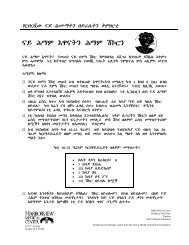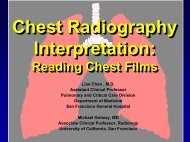Somali Knowledge Attitude Practices Study (KAPS) - EthnoMed
Somali Knowledge Attitude Practices Study (KAPS) - EthnoMed
Somali Knowledge Attitude Practices Study (KAPS) - EthnoMed
Create successful ePaper yourself
Turn your PDF publications into a flip-book with our unique Google optimized e-Paper software.
2.1.2 Health and Nutrition Situation of Children in SCZ<br />
The rates of child mortality have been among the highest in the world 1 . Whereas the baseline<br />
under-5 mortality rate (U5MR) for sub-Saharan Africa is about 1.03 deaths/10,000 U5s/day 2 , in<br />
Southern and Central <strong>Somali</strong>a zones, the U5MR has remained above 2 deaths/10,000 U5s/day,<br />
particularly in the southern parts (Gedo and Juba regions) 3 of the zone. These mortality rates are<br />
unacceptably high as per Sphere Standards where U5MRs should be maintained at below<br />
2.0/10,000 U5s/day. 4<br />
Analysis of trends in nutritional status in the past three years also indicate that Global Acute<br />
Malnutrition (GAM) rates have been above 15% in all livelihood zones of South and Central<br />
<strong>Somali</strong>a throughout the years. 5 These rates are unacceptably high and indicate a serious situation<br />
according to both WHO and RNIS benchmarks.<br />
The observed deterioration in health and nutrition situation of children over the years in South<br />
and Central <strong>Somali</strong>a zones has been mainly attributed to the complex socio-political and natural<br />
environment of frequent conflicts, causing population displacements and loss of assets; poor<br />
knowledge in health and feeding practices; inappropriate traditional beliefs and poor hygiene and<br />
sanitation with inadequate safe water supply. The recurrent drought and floods in the recent past<br />
have further led to reduced food production and poor animal health conditions. According to<br />
seasonal food security assessment reports by FSAU 6 , significant proportion of the populations in<br />
rural Southern <strong>Somali</strong>a, particularly Gedo, Juba and parts of Bay, Bakool and Hiran have been<br />
within the Humanitarian Emergency and Acute Food and Livelihood Crisis phases of the<br />
Integrated Food Security and Humanitarian Phase Classification (IPC), and in need of<br />
humanitarian assistance and livelihood support over the course of recent years.<br />
The most commonly reported childhood illnesses in South and Central <strong>Somali</strong>a are diarrhoea,<br />
acute respiratory infections (ARI), skin infections, intestinal worms, malnutrition, malaria,<br />
measles, whooping cough, tonsillitis, eye infection and anaemia, with the major ones being<br />
diarrhoea, ARI, malaria and measles.<br />
Source: FSAU Nutrition Data Base, 2007.<br />
Both modern and traditional medicines are widely used in the management of illnesses in the<br />
region. Most illnesses are traditionally associated with spirits and “Evil Eyes”. Modalities used to<br />
treat illnesses normally include fire-burning, herbal remedies, casting and prayer. Illnesses like<br />
headache, fever, dizziness and weakness are believed to be caused by spirits. Treatment therefore<br />
involves reading the Koran, eating special food and burning incense (myrrh). 7<br />
Immunization coverage for all the vaccines is notably low, except for polio. The polio<br />
immunization coverage is generally high due to the national immunization days as well as doorto-door<br />
campaigns which are regularly conducted in all places.<br />
1<br />
UNDP. 2006. Millennium Development Goals (MDG) Report. UNP.<br />
2<br />
The Sphere Project. 2004. Humanitarian Charter for Minimum Standards in Disaster Response.<br />
3<br />
FSAU Technical Series Reports No Volumes 9-13<br />
4<br />
The Sphere Project. 2004. Humanitarian Charter for Minimum Standards in Disaster Response.<br />
5<br />
FSAU Nutrition Data Base 2007.<br />
6<br />
FSAU Technical Series Reports on Seasonal Food Security Assessments.<br />
7<br />
Toby Lewis (1996) <strong>Somali</strong> Cultural Profile http://ethnomed.org/ethnomed/cultures/somali/somali_cp.html<br />
17






